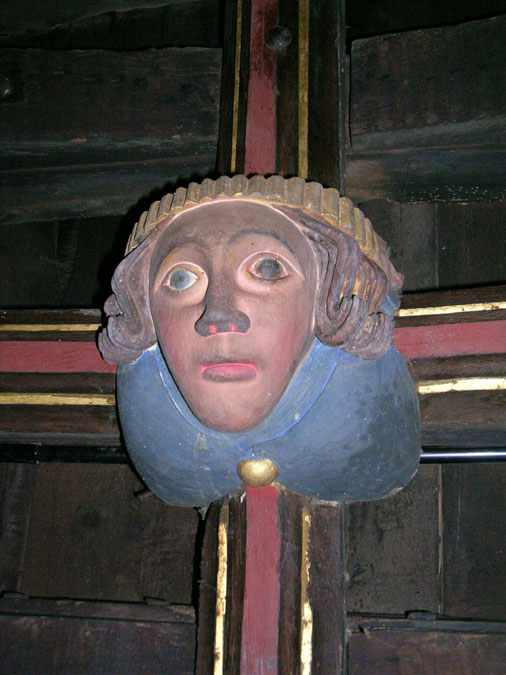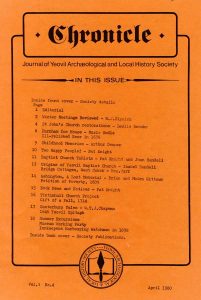This article came from Chronicle published April 1980. Pages: 2-3
Winter Meetings Reviewed
Author: R.J.Glynick
The 1979-80 session opened with the AGM and was held, as were all our winter meetings, in Yeovil Reference Library by courtesy of the Library Committee, and with the Chairman, Miss I.Rendell presiding. This took place on 5 October and in her address Miss Rendell reviewed the very successful programme of the preceding year and also commented on the Society’s publications. Following Mr Hayward’s excellent work ‘The Romans at Ilchester, Lufton, Yeovil, and District’ came Leslie Brooke’s ‘Street Names in Yeovil’, and in addition there had been two issues of ‘Chronicle’, the Society’s own publication with had been made available to members. She hoped her listeners would be prompted to make contributions to forthcoming issues and so build up a very useful record of the Society’s activities. It was hoped to publish further booklets at a later date. In conclusion, Miss Rendell announced that Hr L.C.Hayward had been elected President of the Somerset Archaeological and Natural History Society, an honour not only for him but also for the Society. Election of Officers for the ensuing year resulted in the following appointments: Chairman, Miss I.Rendell; Hon.Secretary, W.T.J.Chapman; Hon. Treasurer, R.Gilson; Committee, Rev G.Robinson, R.Gilson, R.J.Clynick. An amendment to the constitution allows Mrs Pat Knight officially to become the Society’s Librarian, while Leslie Brooke remains Publications Editor, both being ex officio members of the committee. The balance sheet was presented by the Secretary who reported that though there had been a slight drop in receipts, and a loss on coach outings, the funds were in a satisfactory state, and no increase in subscriptions for the coming year was contemplated. Following ‘Coffee Break’ Mr Hayward gave an illustrated account of the exhumation of a shallow grave in a garden in Mudford Road, thought to be the double burial of plague victims in the 17th century, and the evening was rounded off by a showing of slides by Leslie Brooke, taken during the summer excursions, and these were augmented by an album of colour photographs taken by Mrs Brooke, all reviving happy recollections of those occasions.
Miss Mary Whitfeld addressed the Society on 2 November, her subject being Bretton Seymour, an historic village situated between Wincanton and Castle Cary. Illustrated by excellent slides, she traced its history from Roman times through to the 19th century and, with a series of maps made over several centuries, and rare illuminations from medieval manuscripts, now in the Bodleian Library, traced the development and changing pattern of agriculture with its open-field system. There was a Roman settlement nearby which had been recorded. The layout of the village has remained almost the same from the earliest times, the main street being, it is said, part of a pilgrims’ way from Poole to Glastonbury. The population of Bretton Seymour is still small, and, said the speaker, always had been; the village only just managed to survive the ravages of the Black Death in the Middle Ages.
‘Current Archaeology in Somerset‘ was the title of the address given by Mr I.Burrow, Field Archaeologist for the County, on 7 December. His own particular interest, he said, was in forts and hill-sites, and moated medieval sites. He had recorded many of the latter in the county, but felt sure there were still many more to be found. Defining his work as advisor to the County Council when development areas were under discussion, his task was to prevent the loss of archaeological sites, to preserve existing historic buildings, and to decide what should be retained, both in the public and private sectors. lie also dealt with the controversial utter of the use of metal detectors on known or potential historical and archaeological sites, pointing out that recent legislation had made them illegal in this context with heavy penalties for infringement. The recent excavations on a site behind the County Hotel, Taunton, where it had been hoped to reveal evidence of Saxon occupation, was illustrated by slides, the speaker saying that though no such evidence was obtained there was clear indication of the town’s expansion in the 13th century.
Two of our Society’s own members entertained us on 4 January, the first speaker being Yeovil Librarian Mr Eric Dove, who with the aid of excellent slides, showed the great changes which had taken place in Yeovil during the past 150 years. Pictures of last century Yeovil together with some of more recent date, were contrasted with up-to-date colour slides of the same venues, and brought home to viewers the drastic changes which have been wrought within the past twenty years. The coming of the motor car had necessitated the clearance of large areas in the town for car parks, and familiar roads and streets had been drastically widened and straightened to accommodate an ever-increasing volume of traffic. Despite the disappearance of familiar scenes the speaker thought that the ‘Dove’s-eye’ view he had presented were, on the whole, for the better. Mr and Mrs Brooke’s recent holiday in York, was next described by Leslie in a set of beautiful slides which were of both archaeological and historical interest. The magnificent. Minster, dominating the city, was well described in great detail. The city is rich in Roman and medieval gems; these include the city’s gates, or bars, ancient shop signs and ‘street furniture’, countless historic buildings of differing character, the museums and castle, and of course the ancient city walls which can be walked upon with ease. Shown, too, were the remarkably fine ruins of both Fountains Abbey and Rievaulx, and slides of these showed the grandeur and richness of these great religious foundations.
The February meeting was addressed by Mr Robin Bush MA the deputy county archivist of the Somerset Record Office at Taunton. His theme was ‘Life and Laughter in Old Somerset‘, A chance remark or written account which found its way into recorded public documents was capable of passing into history many years later, he said, and he defined an archivist as the keeper of public records of many kinds, including church accounts, wills, parish registers, proceedings in courts of law and local authorities, deeds, private and public documents of historical importance, and even the seemingly unimportant items of village gossip, to name but a few. A clever raconteur and wit, Mr Bush delighted his audience with many examples from these records, amusingly related, and from memory. He instanced the tracing back through well-researched documents, the genealogy of a family over a fantastic number of generations. He also suggested that since this was a public meeting some chance remark made by someone present could eventually find its way into the archives, to be researched and revealed in the years to come!
‘The Somerset Peatlands, or Wetlands‘ was the subject of a film and talk given by Mr Brian Storer, Field Officer of the Somerset Trust for Nature Conservation on 7 March. Mr Storer, who has written an authoritative book on the subject of Sedgemoor, said the wetlands was a remarkable area of some 250 square miles, bounded by Bridgwater Bay, the Mendips, the Quantocks, and Taunton, and is subject to annual flooding, much of it being below sea level. An elaborate system of.drainage channels and pumping stations has enabled much of the area to be given over to fragmented agriculture at varying levels to accommodate both arable and dairy farming. The partial take-over of the ‘wetlands’ has brought about the loss of many of the rare species of wild plants and of the habitat for animal life of many kinds. In addition the industrial exploitation of large areas of the deep Peat Beds, has only aggravated this loss. The film showed both flora and fauna through the changing seasons of the year., and the progression of change in field and drainage, and how, with careful planning and compromise, restoration of a natural balance can eventually be achieved.
As these notes go to press before the final winter meeting, this opportunity is taken to express our very grateful thanks, not only for the much-appreciated refreshments available at each of these gatherings, but also for all the arrangements (or should we say re-arrangements?) which of necessity are made by Mr Dove and his assisants both before and after the meetings.

